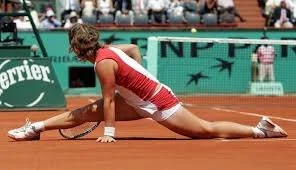If you have watched pro tennis over the years, you likely noticed that Roger Federer keeps his head down and still through the duration of his swing. As you can see here, you will find most pictures show his head still down by the end of his swing. However, every student I have worked with moves their head either before making contact with the tennis ball or while they are making contact. And no matter how many times coaches tell students to keep their head down during the swing, most will never fix this problem. In this article, I will explain why it’s important to keep your head still, the reason most have not been able to truly fix this problem, and the solution to a permanent change.
The reason you must keep your head still as you’re swinging is because when you move your head, your shoulders tend to follow. That leads to opening yourself up too soon before or during the swing. This also means your swing path will shift along with your shoulder movement. This causes one of two errors: (1) if your swing path shifts up before making contact with the ball, your strings will hit the top of the ball and send the ball towards a declining trajectory, which increases the likelihood of hitting short or the net; (2) if your swing path shifts up as you’re making contact with the ball, you will lift the ball up and it will likely sail long.
Why is this happening? Imagine yourself playing tennis. Now, visualize how you’re set for the shot and are about to swing and hit the ball. In the live scenario, what I always witness, is that once the student is set up and ready to swing, their mind has figured out within the few split seconds how to intercept the ball. Confident they will hit the ball; the player then turns their attention to where they want the ball to go. And bam, they don’t hit the shot they intended to because their swing path was altered suddenly.
Many will try to fix this problem by mechanically forcing their head down. But there is a problem with this approach: it’s not sustainable. Forcing your head down and keeping it still means that you must be attentive to keeping your head down. That attention takes away from your state of awareness for everything else. And once you stop focusing on keeping your head down, your problem will resurface. Your best tennis will be played through intuition and not controlled thinking.
The underlying problem is a lack of self-trust and a need to control the outcome of shots. Players move their head because they want to see where the ball goes with a hopeful wish to control the outcome of their shot with eyes. It’s absurd because once the ball leaves your string, you have zero control over where the ball goes. It’s already determined.
This underlying problem brings us back to fear of failure. We don’t like to fail and thus feel the need to control our outcomes. But the world of physics does not know about the tennis scoring rules and it will thus not make any adjustments to make you feel good about yourself. It just tells us we must play by the laws of physics and geometry.
Roger Federer has talked about letting go of outcomes. He learned to trust himself and be OK with missing shots. You can do the same and learn to stay in the moment. All you need to do, is work on letting go of controlling outcomes, being OK with missing, and keeping your mind in the moment.
Mindfulness training and acceptance of missing shots are the best tools to keeping your head still like Roger Federer as you’re swinging. The universe does not care if you win or lose. We invented scoring to make it fun, entertaining, and to measure our progress. Tennis is just a game that teaches you intuitive physics, math, psychology, and athleticism. These benefits far outweigh the need to win points or make your shots in.






